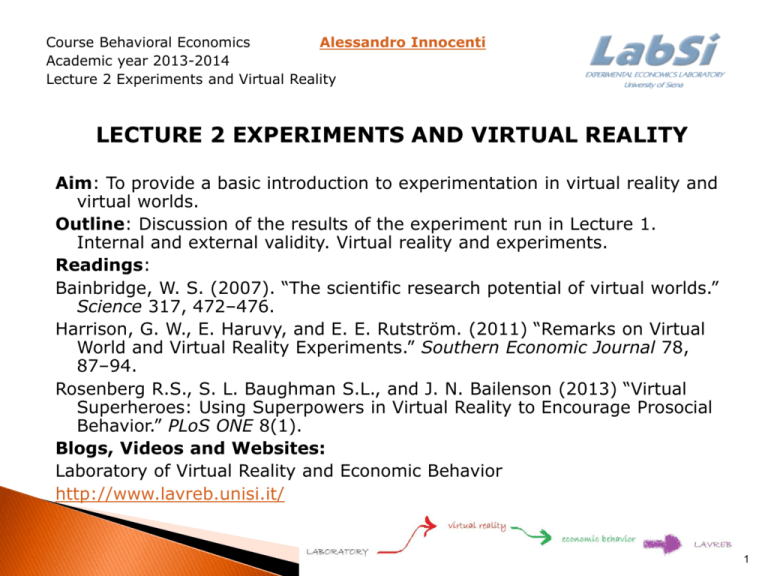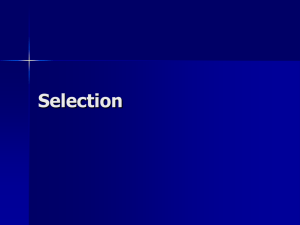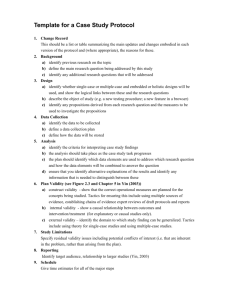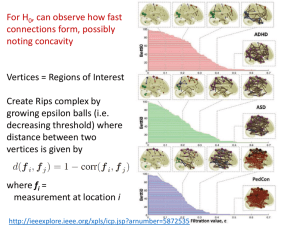Lecture 2 experiments and Virtual reality Aim
advertisement

Course Behavioral Economics Alessandro Innocenti Academic year 2013-2014 Lecture 2 Experiments and Virtual Reality LECTURE 2 EXPERIMENTS AND VIRTUAL REALITY Aim: To provide a basic introduction to experimentation in virtual reality and virtual worlds. Outline: Discussion of the results of the experiment run in Lecture 1. Internal and external validity. Virtual reality and experiments. Readings: Bainbridge, W. S. (2007). “The scientific research potential of virtual worlds.” Science 317, 472–476. Harrison, G. W., E. Haruvy, and E. E. Rutström. (2011) “Remarks on Virtual World and Virtual Reality Experiments.” Southern Economic Journal 78, 87–94. Rosenberg R.S., S. L. Baughman S.L., and J. N. Bailenson (2013) “Virtual Superheroes: Using Superpowers in Virtual Reality to Encourage Prosocial Behavior.” PLoS ONE 8(1). Blogs, Videos and Websites: Laboratory of Virtual Reality and Economic Behavior http://www.lavreb.unisi.it/ 1 Lecture 2 Experiments and Virtual Reality Many experimental economists seem to view their enterprise as akin to silicon chip production. Subjects are removed from all familiar contextual cues. Like the characters 'thing one' and 'thing two' in Dr. Suess' Cat in the Hat, buyers and sellers become 'persons A and B', and all other information that might make the situation familiar and provide a clue about how to behave is removed. George Loewenstein (1999) 3 Lecture 2 Experiments and Virtual Reality The context-free experiment is an elusive goal and not necessarily a good thing Games in the laboratory are usually played without labels but subjects inevitably apply their own labels A major discovery of cognitive psychology is how all forms of thinking and problem solving are context-dependent (language comprehension) The laboratory is not a socially neutral context, but is itself an institution with its own formal or informal, explicit or tacit, rules Lecture 2 Experiments and Virtual Reality Internal validity - ability to draw confident causal conclusions from one's research External validity - ability to generalise from the research context to the settings that the research is intended to approximate Experiments have the reputation of being high in internal validity but low in external validity Field studies of being low in internal validity but high in external validity Lecture 2 Experiments and Virtual Reality One of the basic tenets of laboratory methodology is that the use of non-professional subjects and monetary incentives allows making subjects’ innate characteristics largely irrelevant In some experiments, it is as if subjects take into the lab the preferences applied to real choices and stick to them with high probability These biases or inclinations tend to override the incentives effect Labels may give subjects clues to become less and not more rational Lecture 2 Experiments and Virtual Reality Subjects’ behavior depends more on prior learning outside the laboratory than on expected gains in the laboratory Labels have the power to increase external validity with a minimal sacrifice of the internal validity To test learning and cognitive models, it is necessary to remind and to evoke contexts which may activate emotions, association, similarities in the laboratory The use of presentations with virtual reality (VR) visualisations can convey objectively this kind of information A Virtual Experiment combines insights from virtual reality (VR) simulations in computer science, naturalistic decision making (NDM) and ecological rationality from psychology, and field and lab experiments from economics Lecture 2 Experiments and Virtual Reality The methodological objective of Virtual Experiments is to combine the strengths of the artificial controls of laboratory experiments with the naturalistic domain of field experiments or direct field studies In a virtual experiment the internal validity of controlled lab experiments is joined with the external validity of field experiments 11 14 Lecture 2 Experiments and Virtual Reality Fiore et al. 2009 Virtual Experiment to elicit subjective risk perception from wild fires and the opportunity cost of public funds allocated to prescribed burns Subjects experience four dynamic visual simulations of specific wild fires, with varying weather and fuel conditions. Simulations are selected to represent high and low risk of fire damage Participants experience a sense of presence, a psychological state of “being there and take decisions closer to real behavior (with cognitive constraints ) Lecture 2 Experiments and Virtual Reality Applications- Virtual Superheroes to Encourage Prosocial Behavior http://www.youtube.com/watch?v=wnQgDsdy7zg Background Playing prosocial video games leads to greater subsequent prosocial behavior in the real world. Thesis In immersive virtual reality occupying an avatar with the superhero ability to fly increases helping behavior. Methods (two-by-two design) participants were either given the power of flight and were assigned one of two tasks, either to help find a missing diabetic child in need of insulin or to tour a virtual city. Findings The results indicate that having the “superpower” of flight leads to greater helping behavior in the real world 17 Figure 2. Foggy virtual city. Rosenberg RS, Baughman SL, Bailenson JN (2013) Virtual Superheroes: Using Superpowers in Virtual Reality to Encourage Prosocial Behavior. PLoS ONE 8(1): e55003. doi:10.1371/journal.pone.0055003 http://www.plosone.org/article/info:doi/10.1371/journal.pone.0055003 Figure 3. Virtual Child After Being Found and Saved. Rosenberg RS, Baughman SL, Bailenson JN (2013) Virtual Superheroes: Using Superpowers in Virtual Reality to Encourage Prosocial Behavior. PLoS ONE 8(1): e55003. doi:10.1371/journal.pone.0055003 http://www.plosone.org/article/info:doi/10.1371/journal.pone.0055003





